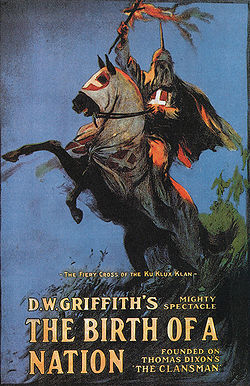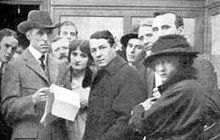The Birth of a Nation
From Wikipedia, the free encyclopedia
The Birth of a Nation (asalnya dipanggil The Clansman) merupakan filem senyap epik Amerika Syarikat 1915 yang diarahkan dan diterbitkan oleh D. W. Griffith serta dibintangi oleh Lillian Gish. Ia merupakan adaptasi dari novel dan pementasan The Clansman, oleh Thomas Dixon Jr.. Filem ini ditulis oleh Griffith bersama-sama Frank E. Woods.
| The Birth of a Nation | |
|---|---|
 Poster iklan filem | |
| Pengarah | D. W. Griffith |
| Lakon layar | D. W. Griffith Frank E. Woods |
| Berdasarkan | The Clansman oleh T. F. Dixon Jr. |
| Dihasilkan oleh | D. W. Griffith Harry Aitken[1] |
| Dibintangi | Lillian Gish Mae Marsh Henry B. Walthall Miriam Cooper Ralph Lewis George Siegmann Walter Long |
| Sinematografi | G. W. Bitzer |
| Disunting oleh | D. W. Griffith |
| Muzik oleh | Joseph Carl Breil |
Syarikat penerbitan | David W. Griffith Corp. |
| Diedarkan oleh | Epoch Producing Co. |
Tarikh tayangan |
|
Masa tayangan | 12 gelung 133–193 minutes[2] |
| Negara | AS |
| Bahasa | Bisu |
| Bajet | >$100,000[3] |
| Pecah panggung | unknown; estimated $50–100 million[4] |

Filem ini menjadi penuh kontroversi atas penampilan watak-watak berkulit hitam ia sebagai berperwatakan ganas (dilakonkan banyak pelakon berkulit putih dalam solekan khas) serta bernafsu buas terhadap wanita, serta menggambarkan Ku Klux Klan - sebuah kelompok pemerjuang ketuanan kulit putih - sebagai wira,[5][6] malah penayangan filem ini menjadi antara faktor penting dalam penaikkan nama serta pembentukan semula kelompom tersebut pada tahun 1915. Terdapat banyak tunjuk perasaan dalam golongan masyarakat kulit hitam terhadap penayangan filem dini di serata Amerika Syarikat.[7]
Barisan pelakon
- Lillian Gish
- Mae Marsh
- Henry B. Walthall
- Miriam Cooper
- Mary Alden
- Ralph Lewis
- George Siegmann
- Walter Long
- Wallace Reid
- Joseph Henabery
- Elmer Clifton
- Josephine Crowell
- Spottiswoode Aitken
- George Beranger
- Maxfield Stanley
- Jennie Lee
- Donald Crisp
- Howard Gaye
Tiada kredit:
- Robert Harron
- Edmund Burns
- David Butler
- William Freeman
- Sam De Grasse
- Olga Grey
- Russell Hicks
- Elmo Lincoln
- Eugene Pallette
- Harry Braham
- Charles Stevens
- Madame Sul-Te-Wan
- Raoul Walsh
- Lenore Cooper
- Violet Wilkey
- Tom Wilson
- Donna Montran
- Alberta Lee
- Allan Sears
- Vester Pegg
- Alma Rubens
- Mary Wynn
- Jules White
- Monte Blue
- Gibson Gowland
- Fred Burns
- Alberta Franklin
- Charles King
- William E. Cassidy
Rujukan
Pautan luar
Wikiwand - on
Seamless Wikipedia browsing. On steroids.
